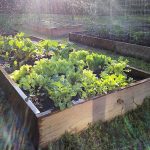I made my first terrarium garden in the first grade. It was in a plastic shoebox, and I brought it to school as a gift for my teacher. When it came time for the class picture, she said, “Let’s make sure we have the class mascot in it!” and there it is – the terrarium. My friend Gina got the honor of holding the terrarium for the class photo.
We used a plastic shoebox. It had a green base and a clear cover, like a dome, which made a perfect little terrarium setup. I can’t remember which plants we included, but I do remember using a screwdriver to dig up moss from between the sidewalk cracks on our front walkway and getting yelled at by my not-so-understanding father, who justifiably thought his tools were ruined.
I remember carefully carrying the terrarium with Gina down the hallway of our grammar school to the girl’s bathroom outside the principal’s office. There we would place it in the sink and carefully wash the leaves. You don’t have to wash the leaves. We just thought it was a nice thing to do for the plants.
I am amazed that the entire thing survived the first grade.
Whatever happened to the terrarium is a mystery. I don’t know if my teacher took it with her when she moved to a new school, whether it died – perhaps from being overwatered, perchance? Or whether the new first grade teacher kept it for her classroom.
I’ve always loved terrariums, from the kitchy sand-garden terrariums of the 1970s to the really neat photo of a decades-old sealed terrarium that I saw in an article a few months ago. Terrariums can be open, like the one I brought to my first grade teacher, or sealed. The sealed ones fascinate me. When the terrarium is sealed, it becomes its own little microcosm. The water evaporates and drips back onto the plants. Decaying plant matter ‘feeds’ the plants, too. Plants can live for decades in sealed terrariums if they are set up correctly.
To make a terrarium, start with a clear glass container. It should have a wide opening to make it easier to work with. Put a layer of stones on the bottom for drainage. Some people recommend adding about a teaspoon of activated charcoal over the stones; it helps control any odor that might occur from decaying plant material. (I don’t use the charcoal but have seen it recommended often enough that it’s probably a good idea.) The rocks provide space for extra water, so that it drains away from the plants’ roots in the terrarium. It also makes the bottom of the terrarium look nice.
Add sterile potting soil next. You’ll want to measure your plants inside the terrarium at this point to make sure they fit inside when planted. What plants should you use? Look for low to medium light house plants. I like creeping fig, ferns, pothos and other small houseplants. I have one terrarium here, however, that’s made entirely with cacti and succulent. I keep the top off and used a growing medium for cacti, which creates a mini desert, and I keep it in bright light. It is thriving and the cactus even bloomed once!
Use a spoon and your fingers and gently plant the houseplants, making sure that they fit inside the terrarium even with the lid on it. To tamp down the soil, use a spoon to press it down. Add moss. Spray the inside with water from a spray bottle and place the lid on it. Water the terrarium every few weeks. If you use a lid on it, take the lid off once a month to let the terrarium air out, then water and replace lid.
Terrariums are fun and beautiful. They always remind me of the Victorians and their love for mini conservatories and indoor gardens.
If you live near the Farmville, Virginia area, then I hope you sign up for the terrarium gardening workshop to be held at B & M Greenhouse on Saturday, March 2, 2013 at 10:30. There is a materials fee. It should be a lot of fun!
For more terrarium gardening information and help, see:





